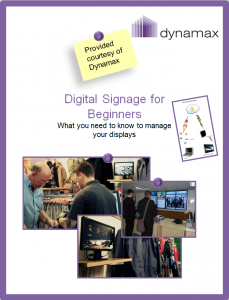As we’ve stated in the first part of this advice series, digital signage is another technology platform that allows you to communicate with customers, staff or students, depending on your organization. But unlike other channels, such as the mobile or the online ones (website, social media etc.) this can amass information from- and create a link between them all to ensure your message is consistent and accurate.
A digital signage solution has its set of challenges that- as we will see from the marketers’ commentary below – are quite common to the other marketing channels.
- Measurement
Probably one of the most challenging matters when it comes to digital signage is measuring its ROI. Is the solution really achieving what it was meant to and if yes, how effectively? Identifying the metrics and assigning a different degree of importance to each would solve half of the problem, says James Papworth (the Professional Publishers Association) but this is not that easy in fact. The issue gets even more complicated when it comes to measuring more ‘immaterial’ aspects with an indirect financial benefit such as brand sentiment, awareness or customer experience.
Dominic Grounsel , the marketing director of insurance company More Th>n seems to agree with this idea ‘’From a client point of view [as opposed to agencies], it’s measurement and ROI, because that’s incredibly difficult with multiple channels running simultaneously’’.
But as challenging as it may be, measurement still remains an important part of your project. So track the quantity of products sold after you’ve installed the system and compare it with the one before; do the same with the number of new subscriptions, new customers, attendees to events or whatever you are offering/ selling/ communicating. If the difference is positive, then continue doing what you’re doing because it works!
You may also want to take into consider the savings since using digital signage should imply reduced printing costs for example, or lower transportation costs that were once incurred for distributing or updating communications.
‘’There’s money to be made, but it’s working out how you divert the resources that you’re currently using in one place to another’’ says Papworth of PPA. It’s measurement that will help you re-adjust your initial plan according to actual results and not guesswork.
2. Ownership
Marketers tend to agree that in the multi- channel marketing world, deciding or knowing who is responsible for what could become a dilemma. When it comes to digital signage- you will have to decide who owns the implementation, who is responsible for content creation, for the system’s management and for the measurement of its ROI. An AV company will usually be responsible for the digital signage’s maintenance or in other cases the vendor itself might provide customer support. In any case, there is a high chance that you will have to deal with external partners.
As the marketing department may detain the headship of the entire project it will be its direct responsibility to oversee the performance of the various parties that fulfill various duties. The worst thing you can do is not having anyone oversee the digital signage system or having one single person responsible for all the tasks enumerated above.
Other pearls of wisdom from the interviewees of the Marketing magazine*
1) Dare to be different – ‘’Tech is exciting. It’s absolutely the right thing we should focus some of our time on…Most campaigns that give customers a pleasurable marketing experience are simple or immersive and engaging but they all have a small element of innovation’’ (Jem Lloyd- Williams, head of digital strategy, MediaCom). Your digital signage solution shouldn’t be a replica of that of another organization. Adjust the system to fit your particular needs. Different messages, media files, screens placement or hardware used are one of the most common elements of variation.
2) Align creativity to your objectives- ‘’Creativity is something that’s magical in marketing. The science is to say: these are our objectives, strategy and challenges- if you build creativity round that, you harness creativity with a purpose.’’ (Bruce McColl, chief marketer at Mars). It’s great to adopt touch- screen technology but if your audience is over 60 for example, this might not work well. Videos make for great digital signage content but if they are long and displayed in low dwell locations, they’re just going to be ineffective.
3) Strategy should drive the use of technology and not the other way around- ‘’You need to ask whether they (new technologies) fit with your key strategies, rather than letting your strategies adapt to them.’’ (McColl, Mars). Digital signage can come with many bells and whistles (see Tweet and Facebook mirrors, NFC and Augmented Reality campaigns). The question is- do you really need this? We offer different widgets in digitalsignage.NET, but not all of them are relevant to anybody. If people aren’t particularly interested in the weather when in your location but would rather have you offer some other information then the Weather widget is impractical for you. Opt for new technology that aligns with your strategy.
4) Be relevant and cut through the information clutter- ‘’We’ve got to make things relevant [to consumers] because we can’t predict their behavior…Not only have we got to communicate and be relevant at the right time, but we gave to reach that minutest spot among all that information to actually engage…Technology can help us if used in the right way’’ (Steve Willmore, co-founder of Monk for the Marketing Magazine*)
Sources:
* ‘’Solving the integrated dilemma’’, Marketing magazine, 15 August 2012
* *The Marketing Interview- Bruce McColl-Mars, Marketing magazine, 18 July 2012
Want to learn more? Download our white paper.
Want to talk to a digital signage expert about getting your system up and running? Click here to request a FREE consultation.
About Dynamax
We are one of the longest standing digital signage providers in the world, whose solutions are reaching over 30 million consumers every week, all around the globe. digitalsignage.NET, our cloud- based digital signage solution enables organisations from various sectors to disseminate timely and accurate information on interconnected screens installed in their locations.


